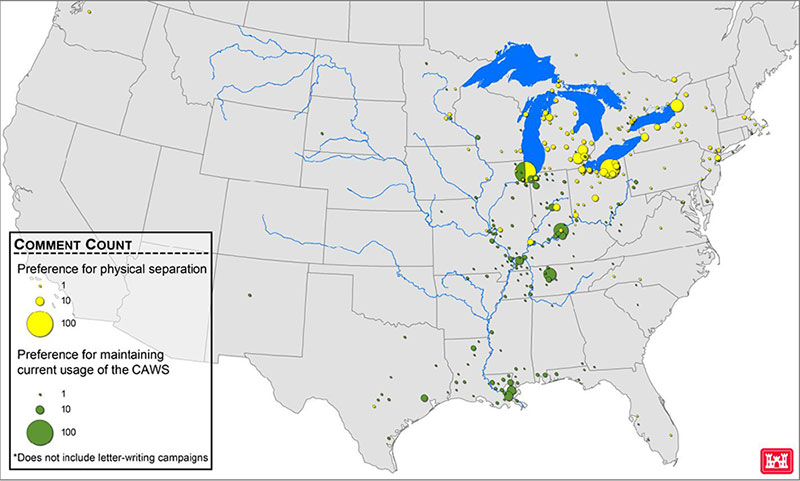Summary of Public Comments on GLMRIS Released
Corps posts summary of public comments for report on Asian carp, invasive species controls

A map demonstrating where physical separation is supported based on public comments. Image courtesy of the U.S. Army Corps of Engineers.
CHICAGO - The U.S. Army Corps of Engineers posted a summary May 5, 2014, of comments submitted and recorded for administrative record during the public comment period for the Mississippi River Interbasin Study (GLMRIS) Report. The GLMRIS Report outlines eight potential plans within the Chicago Area Waterway System (CAWS) to address the transfer of aquatic nuisance species, such as Asian carp, between the two basins.
The comment summary includes information on the study; the public comment process; a summary of comments by location and themes; commenter demographic information; Corps clarification on several recurring themes; and the path forward on GLMRIS. The comment summary can be viewed at http://glmris.anl.gov/.
"This document is intended to provide a synopsis of the public dialogue following the release of the GLMRIS Report, including opinions regarding possible future prevention actions," said Dave Wethington, GLMRIS program manager. "The comments submitted reflect passion about preserving valuable natural resources and the vitality of our shared waterways."
More than 1,600 comments were submitted from more than 1,800 individuals, organizations, state and local government agencies from 43 states, and the Canadian provinces of Ontario, Quebec, and British Columbia. This does not include input provided though letter-writing campaigns.
Nearly 2,300 people from Illinois, Ohio and Wisconsin submitted a comment as part of a Sierra Club campaign, in which a common form letter stated that hydrological separation is the only permanent solution that addresses all aquatic invasive species. In addition, Clean Wisconsin submitted a petition via the GLMRIS project website that was signed by more than 5,000 people. Their letter argued for the permanent, physical separation of the Great Lakes and Mississippi River basins and named GLMRIS Alternatives 5 and 6 as the preferred alternatives.
More than half of the individual comments originated from Michigan, Illinois, Ohio and Indiana. Among the general themes from individual respondents, more than 98 percent of the commenters expressed support for the need to control ANS; 40 percent favored an alternative that involved some type of physical separation; and 35 percent wanted an alternative that maintained current uses of the CAWS, predominantly navigation. Most of the commenters did not indicate a specific plan. Physical separation plans 5 and 6 were mentioned most often at 12 percent.
The comment period began the day the GLMRIS Report was sent to Congress Jan. 6, 2014, and ended March 31, 2014. Comments were submitted via 11 public meetings, electronic submittal on the GLMRIS website and via e-mail, as well as conventional mail.
Public meeting locations included stops in Traverse City, Mich., and down to New Orleans to obtain comments from a diverse group of interested parties. More than 650 people attended the GLMRIS Report public meetings, from 13 states, and the Canadian Province of Ontario. More than 60 percent of participants at these meetings listed the states of Michigan, Illinois, or Ohio as their home address. About 185 individuals - including state senators, attorneys general, fishermen and shipping interests - provided oral comments at one or more of these meetings.
The alternatives presented in the GLMRIS Report range from continuing current efforts like the operation of electric barriers in the Chicago Sanitary and Ship Canal, to hybrids of technologies and physical barriers, to a complete hydrologic separation of the two basins with physical barriers. Although the report is not a decision document, it includes an evaluation matrix of the alternatives to provide as much detail as possible for decision makers.
The CAWS is a complex, multi-use waterway and is the primary direct, continuous inter-basin connection between the Mississippi River and Great Lakes basins. Each plan includes measures to address potential adverse impacts to existing uses of the waterways, which include maintenance of water quality, flood-risk management, and navigation.
The GLMRIS Report was authorized by Section 3061(d) of the Water Resources Development Act of 2007 (WRDA 2007), and modified by Section 1538 of the Moving Ahead for Progress in the 21st Century Act (MAP-21), directing the Corps to look at a comprehensive range of options and technologies available to prevent the inter-basin transfer of ANS between the Great Lakes and Mississippi River basins through aquatic pathways.
